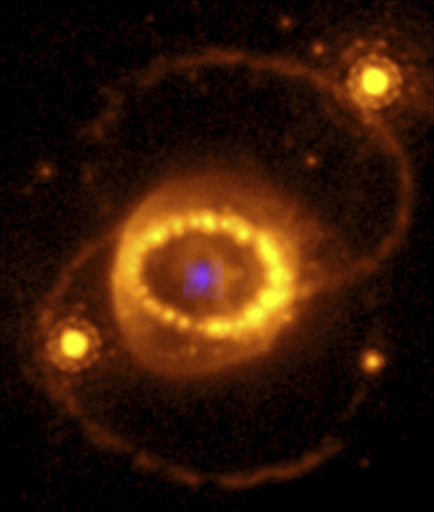Scientists have confirmed what became of a star that exploded in a stunning supernova visible to Earth more than three decades ago: It morphed into a neutron star, one of the oddest objects in the universe.
In 1987, a star in a nearby galaxy went supernova and its fiery demise was detected in Earth’s nighttime sky with the naked eye for months. Scientists figured when its core collapsed, the remnants would turn into one of two things: a black hole, where nothing escapes; or a neutron star, the most dense object in the universe besides a black hole.
The trouble was there was so much debris, astronomers couldn’t see past the dust. But NASA’s Webb Space Telescope cut through the clutter by peering in infrared light and saw two telltale chemical signatures — argon and sulfur — of a pulsing super-hot neutron star, according to a study published Thursday in the journal Science.
Since the explosion was recent and well-tracked, this discovery should help astronomers better understand this type of cosmic oddball and its predecessors that helped seed the universe with important elements such as carbon and iron.
This neutron star is only 12 miles (20 kilometers) from end to end, yet weighs 1 1/2 times our sun. It’s densely packed with little space between parts of its atoms. The aftermath of the so-called supernova 1987A is likely the only time modern astronomy has witnessed the birth and early years of a neutron star, even though there are closer but older ones in our own galaxy, scientists said.
“Besides the black hole, these are the most exotic objects we have in the universe,” said lead author Claes Fransson, an astrophysicist at Stockholm University in Sweden. “We know about these objects from the 1960s, but we haven’t seen any of them being really formed.”
Images of the distant supernova remnant shows what Fransson calls “a ring of pearls” encircling a cloud of dust. Somewhere in the middle of that dust is the neutron star, he said.
Scientists had long suspected the collapsed core was now a neutron star. But this measurement by the Webb telescope, even though it isn’t a direct image of the neutron star, provides a pretty definitive answer, Fransson and outside scientists said.
The case for a neutron star is well-made, said Stanford University astrophysicist Roger Blandford, who wasn’t part of the study.
Because the supernova explosion was so recent and close, it “is ‘a gift that keeps on giving’, teaching us about neutrinos, the evolution of stars and now what happens following the explosion,” Blandford said in an email.
___
The Associated Press Health and Science Department receives support from the Howard Hughes Medical Institute’s Science and Educational Media Group. The AP is solely responsible for all content.



